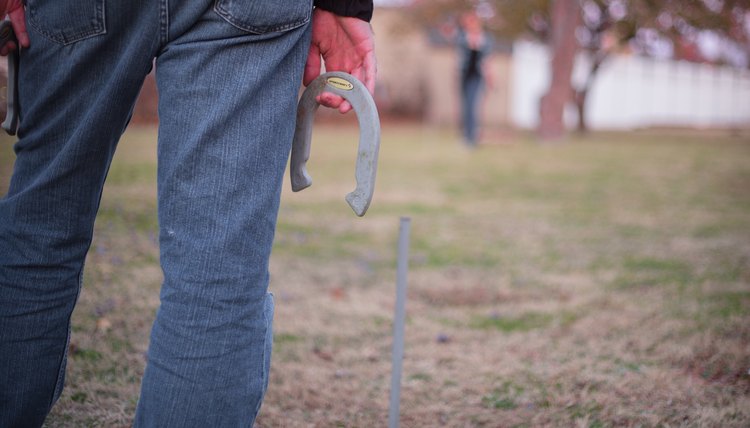What Is Regulation Distance For Horseshoes
What Is the Regulation Distance for Horseshoes?
When it comes to playing horseshoes, it's important to know the regulation distances in order to play the game correctly. Horseshoes is a popular outdoor game that involves tossing horseshoes towards a stake in the ground. In this article, we will discuss the regulation distance for horseshoes and provide you with all the information you need to know to enjoy this fun and competitive game.
Image Source: SportsRec

Playing horseshoes is not only a great way to spend time outdoors with friends and family but also a game that requires skill and precision. The regulation distance for horseshoes is an essential factor that determines the fairness and competitiveness of the game.
Regulation Distance for Horseshoes: A Closer Look

The regulation distance for horseshoes is defined by the National Horseshoe Pitchers Association (NHPA). According to NHPA guidelines, the regulation pitching distance is 40 feet. This means that the stakes (also known as pins) should be placed exactly 40 feet apart in a designated playing area.
The game is typically played in a horseshoe pit, which consists of two stakes and a flat and level playing surface. Each stake is placed in a designated pit area, and players take turns throwing horseshoes towards the opposing stake.
Benefits of Playing Horseshoes at the Regulation Distance
Playing horseshoes at the regulation distance offers several benefits:
- Challenge: Playing at the regulation distance increases the level of challenge and requires players to have better accuracy and aim.
- Fairness: By adhering to the regulation distance, the game becomes fairer for all players, ensuring a level playing field.
- Competition: When everyone follows the same regulation distance, it enhances the competitive spirit and allows for fairer competition among players.
How to Measure the Regulation Distance?
Measuring the regulation distance is crucial to ensure that you set up your horseshoe pit correctly. Here's a step-by-step guide on how to measure the regulation distance:
- Find a flat and level area: Look for an area in your backyard or a nearby park that is flat and free of any obstacles or debris.
- Mark the center: Mark the center of the pit area by placing a stake or a small flag in the ground.
- Measure the distance: From the center stake, measure 40 feet (equivalent to 12.19 meters) and mark the spot. This is where the second stake will be placed.
- Place the second stake: Once you have marked the spot, place the second stake firmly in the ground, ensuring it is vertical and secure.
FAQs About Horseshoe Regulation Distance
Q: Can I play horseshoes without having a regulation horseshoe pit?
A: Yes, you can play horseshoes without a regulation horseshoe pit. However, playing at the regulation distance enhances the overall experience and fairness of the game. If you don't have a horseshoe pit, you can create a makeshift pit by using stakes and marking the regulation distance.
Q: What are the standard dimensions for a horseshoe pit?
A: The standard dimensions for a horseshoe pit are as follows:
- Size of the pit: 6 feet wide by 46 feet long
- Stake height: 15 inches
- Stake diameter: 1 inch
Q: Can children play horseshoes at the regulation distance?
A: Playing horseshoes at the regulation distance can be challenging for children, especially younger ones. It's advisable to allow children to play at a shorter distance until they develop the strength and throwing ability to meet the regulation distance.
In Conclusion
The regulation distance for horseshoes is an important aspect of the game that ensures fairness and competition among players. By adhering to the regulation distance of 40 feet, players can enjoy a challenging and engaging experience. Remember to measure the distance accurately and set up your horseshoe pit accordingly to fully enjoy the game. So gather your friends and family, set up your horseshoe pit, and get ready to toss those horseshoes for an enjoyable and competitive game of horseshoes!
Disclaimer: The information provided in this article is based on general guidelines and may vary depending on individual or local rules and regulations. Please refer to official sources or consult with experts for specific requirements.
The Rules & Distance Of Horseshoes | Horseshoe Game, Horseshoe, Kids
 Image Source : www.pinterest.com
Image Source : www.pinterest.com horseshoe horseshoes livestrong
Backyard Games: Plans For Horsehoes, Bocce, Volleyball, Croquet
 Image Source : www.pinterest.com
Image Source : www.pinterest.com pit backyard horseshoe dimensions horseshoes bocce build plans games croquet horse volleyball shoe court layout rules ball game diagram garden
Horseshoes – Court Craft
 Image Source : www.courtcraft.com.au
Image Source : www.courtcraft.com.au horseshoes horseshoe court craft information incorrect please contact if au
Pin By Candace Stanford On DIY | Horseshoe Pit Dimensions, Horseshoe
 Image Source : www.pinterest.ch
Image Source : www.pinterest.ch horseshoe pit backyard horseshoes regulation bocce
The Rules & Distance Of Horseshoes | SportsRec
 Image Source : www.sportsrec.com
Image Source : www.sportsrec.com distance horseshoes rules distancia herraduras reglas lowstars
What Is The Regulation Distances Between Horseshoe Poles?
 Image Source : www.reference.com
Image Source : www.reference.com Horseshoe Pitching Court Built To Last | Ivey League Landscapes, LLC
horseshoe pit court pitching outdoor game railroad dimensions ties build backyard games built pits last horse yard fire projects back
Downloadable Horseshoe Diagram For Coaches And Players. | National
 Image Source : www.pinterest.com
Image Source : www.pinterest.com horseshoe diagram sports rules dimensions store
Pit backyard horseshoe dimensions horseshoes bocce build plans games croquet horse volleyball shoe court layout rules ball game diagram garden. The rules & distance of horseshoes. Backyard games: plans for horsehoes, bocce, volleyball, croquet. Horseshoe pit backyard horseshoes regulation bocce. The rules & distance of horseshoes